#dorothy michaels
Text
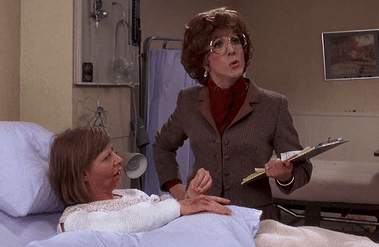
#Tootsie#Dorothy Michaels#Michael Dorsey#Dustin Hoffman#animated gif#GIFcreatedbyMGMpluto#shut up#shut up gif#actor#soap opera#Emily Kimberly#Southwest General#80's#80s
17 notes
·
View notes
Text
Watching Tootsie and I so so badly want Dorothy and Julie to live life as a happy lesbian couple, like is that so much to ask!!
#Michael/Dorothy is so transfem to me you dont understand#she is trans and she should live a long happy life with her lesbian wife#tootsie#Dorothy Michaels#julie Nichols#dorothy x julie#michael dorsey#lgbtq#mine
28 notes
·
View notes
Text
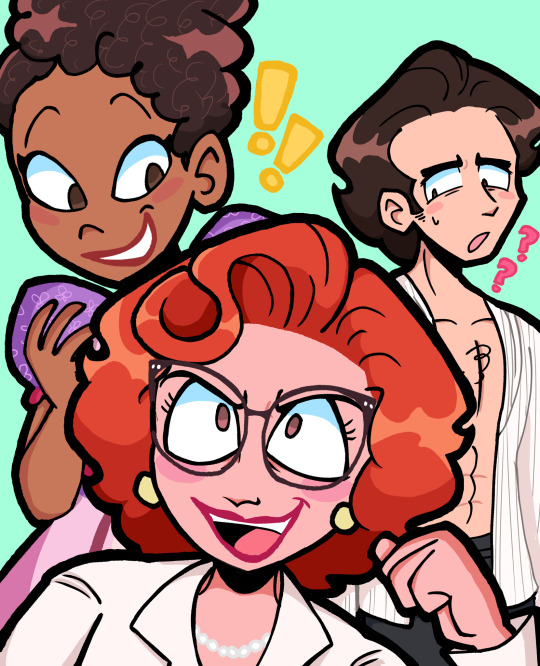
average cement eaters
#reference to the future so you do not yet understand#tootsie musical#tootsie fanart#musical fanart#broadway#john behlmann#santino fontana#lilli cooper#michael dorsey#dorothy michaels#julie nichols#max van horn
13 notes
·
View notes
Text
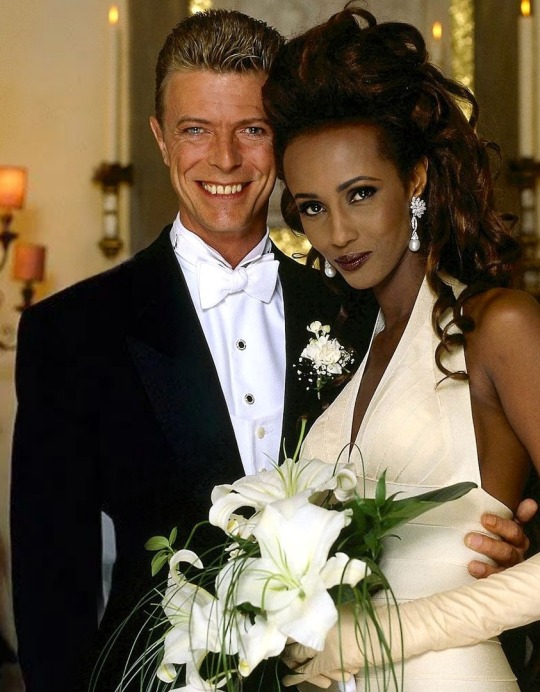






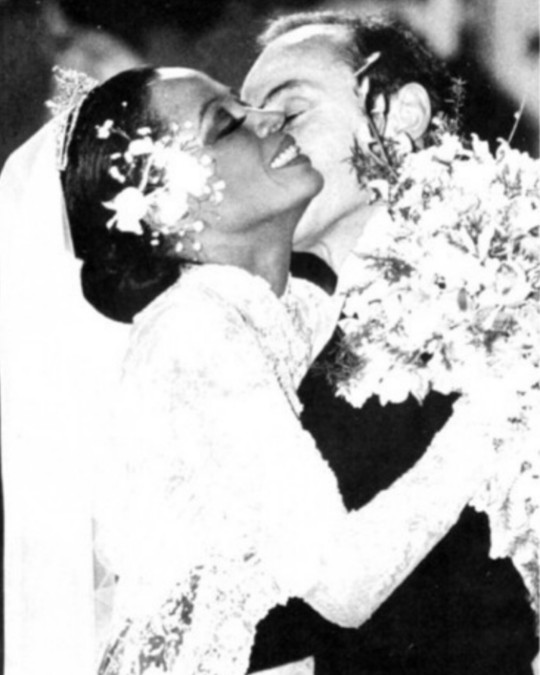

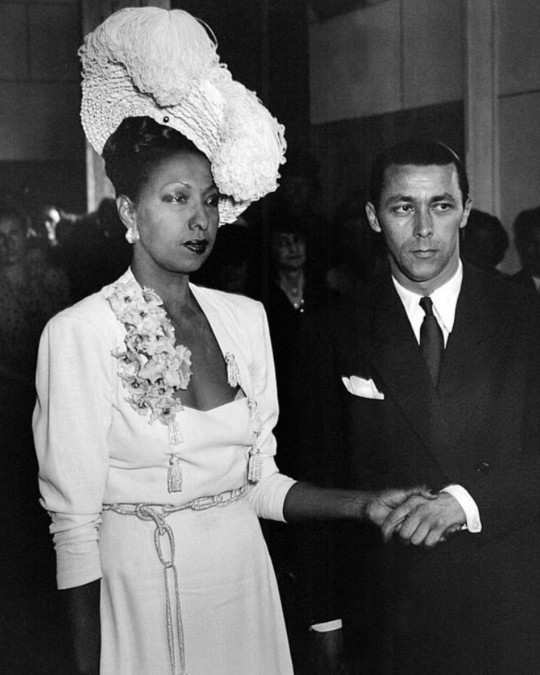
#iman#ingrid bergman#carolyn bessette kennedy#cher#diahann carroll#elizabeth taylor#michael jackson#dorothy dandridge#diana ross#eartha kitt#josephine baker#wedding#vintage wedding#my post
143 notes
·
View notes
Text
Queerwolf By Night: Queercoding, Media Literacy, and Werewolf By Night (part 3)
Lovely to have you back for this, the final part of our examination of WBN being queer as fuck. If you missed the earlier presentations in Media Studies and Writing Hacks With Kat, Part 1 is here and Part 2 is here.
We've gone through the Hays Code AND the AIDS crisis so far, and that's a lot, so could I interest you in a cup of coffee brewed over a campfire?
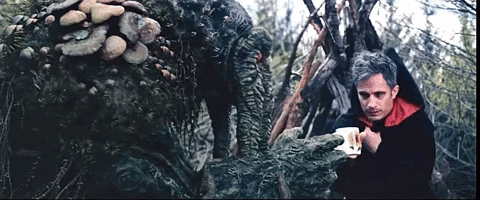
Thanks, Ted. You're a peach.
So let's look at the final scene of WBN through a queer lens. There's a needle drop, color is restored to the world, and we see Jack waking up in the woods to drink coffee, grunt at Ted, and eventually decide that sushi should happen.
(Side note: I have a whole rant about queercoding and sushi, but I cut it, so here's a gif of Aziraphale gayly eating sushi in Good Omens, which you should watch.)
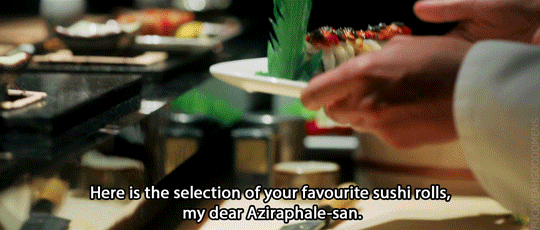
Okay, enough queer angels. Time for more queer monsters.

First things first: this scene is SO DOMESTIC, y'all. They're literally playing house in the woods, in that Ted has built Jack an adorable little house and brewed his morning coffee. The camp is littered with little domestic touches like the French press and the guitar. It's a homey, if slightly eclectic, vibe. (Where did Ted find a payphone?)
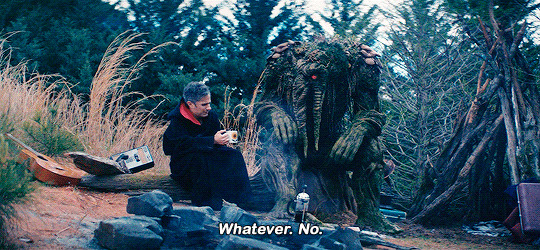
There is no explanation for these objects being there, afaik; Ted and Jack both have presumably come from some distance away, involuntarily in Ted's case, so there's no reason Ted would know the location of a well-stocked camp to put an unconscious Jack down in if Jack even set one up. Presumably the camp is Ted's work, but there's never an explanation for where he got any items other than the robe and the phonograph. (I'm particularly curious about the flower mug, personally.) Yet the objects are not remarked upon, and the entire scene is played as if this is a relatively normal morning for the two of them.
In fact, most of the mechanics of the scene are effectively those of a morning-after scene, perhaps a morning after characters fall into bed for the first time. Jack wakes up groaning, crawls out of bed to see where he is, and finds his partner has laid out something like breakfast for him and is prepared to discuss the events of the night before whenever Jack is ready.
And speaking of that discussion, we once again have displays of queercoded masculinity: Jack and Ted being physically affectionate, playful banter, and emotional vulnerability when Jack asks about Elsa. You know the drill by now. The camera pans up as "Somewhere Over The Rainbow" swells and fades out.
Wait.
Rainbow?
Let's talk about music in this film.
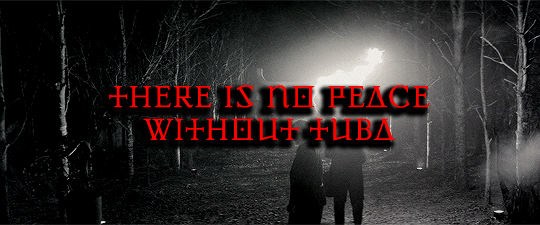
Michael Giacchino is primarily known as a composer of film music. WBN is his directorial debut. I guarantee you've heard his music before, because it's basically in every summer blockbuster franchise. If you can't get John Williams, Danny Elfman, or Hans Zimmer (all of whom are getting long in the tooth), you get Giacchino and he turns in a fucking SCORE.
Now, I am not a music person. Not at all. But even my musically illiterate ass knows that traditional film scoring derives a lot from classical music, especially Romantic composers like Beethoven. And that means LEITMOTIFS, baby!
(I learned about leitmotifs from Bugs Bunny and Star Wars. Do not be impressed.)
A leitmotif is a short musical phrase that can be used to signify a character, object, or theme in a larger work of music. For a very basic example of this, look up the Force theme from Star Wars and watch a supercut of all the times it was used to indicate that someone was using the Force. Or just watch this Sideways video about why the music in Rise of Skywalker was ass:
youtube
Anyhoo. The point of leitmotifs is to give an audience a feeling without necessarily tipping them off to exactly WHY they're having that feeling. And Giacchino LOVES his leitmotifs.
So when he uses someone else's music, he's extremely aware of the emotions that can come attached to that music. It's literally what he does.
There are two pieces of music used in WBN that Giacchino didn't write: a late 1930s recording of Vera Lynn singing "Wishing Will Make It So" and Judy Garland singing "Over The Rainbow" from The Wizard of Oz. Let's start with Vera Lynn.

Vera Lynn was an English singer most associated with big band music before and during WWII. During the war, she was known as "the Forces' sweetheart", both for her efforts to entertain the troops and for the fact that she was kind of every British fighting man's waifu. What Betty Grable's legs were to American GIs, Vera Lynn's voice was to British servicemen. She's best known for the song "We'll Meet Again", which is about exactly what it sounds like. She was a nice lady, by all accounts, and there is a ferry boat named after her now.
A Vera Lynn song about childhood and wishing is what Verussa plays in the labyrinth, apparently to annoy Elsa, who switches it off (even though that's going to inform everyone of where she is). For the purposes of queercoding, Vera Lynn is mom and apple pie, or possibly mum and fish and chips, and above all she is safe, compulsory heterosexuality. The Forces' sweetheart.
Judy Garland, on the other hand, is a queer icon.

I can't overstate what a Big Deal Judy Garland and Dorothy Gale from The Wizard of Oz are in queer culture. The themes of the story, including acceptance of the unusual and embrace of a found family (along with the sapphic elements of some of the books), resonated so deeply with queer people that for several decades, "are you a friend of Dorothy?" was code for "are you gay?" The US Navy actually launched an investigation to find the mysterious "Dorothy" who was supposedly the ringleader of all the gay sailors.
And then there's the song itself, with its theme of longing for a faraway, more colorful place where those who don't fit in at home are loved for who they are. It's, uh, pretty resonant with the queer experience.
So I now draw your attention to the phonograph. Gramophone. Record player. Whatever it's called.
In WBN, we first see the player set up in the labyrinth, presumably by Verussa or at her orders. It's playing a Vera Lynn song about childhood and wishing, which apparently annoys Elsa so much that she switches it off, thus alerting Jack to her location.
The next appearance of the player is in the camp, where it's now playing "Over the Rainbow" beside Jack as he wakes up. Ted has presumably stolen it; there's no other candidate for that, and we already saw him swipe a murder robe for Jack, so why not a record player too?
In other words, Verussa Enthusiastic Heterosexuality Bloodstone sets up the Compulsory Heterosexuality Machine, after which Elsa Ally-Coded Bloodstone turns it off in disgust, and Ted swipes it and turns it gay for Jack's benefit.
That's the coding. That's BARELY subtext. I really don't know what else to tell you. This essay started with my making an offhand joke to bluemoonperegrine about Ted and Jack being "literally friends of Dorothy" and then realizing nobody else in the conversation had noticed this stuff.
So what do we do about all this? Is WBN queer? Does all the Wolfstone stuff pale in comparison to the glory of Russallis? Am I trying to start a ship war in a fandom so small it probably wouldn't fill up Vera Lynn's namesake ferry boat?
Jack, you can answer this for me.

Nope. Not trying to start anything. I happily read Wolfstone, and technically have written some. I love all three WBN leads and am happy to enjoy them in any configuration (although my personal preference is group napping in a puppy pile, because these characters deserve naps).
I just figured it was worth documenting all this so people who haven't had the benefit of my very strange education would be better equipped to recognize (and ideally enjoy) old-style queercoding when they see it.
Wait a minute. You promised writing hacks. It's in the series title and everything.
Shit, you caught me.
Obviously, queercoding isn't a universal tool. There are plenty of storytelling contexts in which it's much better to make characters explicitly queer. Representation matters, and all that.
But sometimes you won't have time for explicit confirmation (like when your story takes place overnight and nobody really has time to play tonsil hockey). Sometimes you won't be able to include it due to outside constraints (like Disney being Disney).
And sometimes, you'll remember that there are plenty of people who can't or won't pick up explicitly queer media. Homophobic parents who won't let their kids watch Love, Simon ... but who WILL let them read your YA novel about unicorns or whatever where there are two female unicorns who are, uh, life partners. Grumpy uncles who refuse to acknowledge their nephew's boyfriend until they notice that, hey, they kinda act like Finn and Poe from that Star War. And so on. Sometimes, coded rep is the best rep you can get ... and so it's useful to have. A good toolbox has ALL the tools.
So if you're building characters for your story and don't or can't have specific queer goals, throw in a little coding. Put a rainbow T-shirt on a kid. Let two boys hold hands or have literally any feelings. Let a girl say a girl is pretty. Look up some of the older symbols for queer love and have someone growing lavender in their garden, or use newer queer symbols and have a character crack an egg in a key scene. Have a character who's content without a romantic or sexual relationship, and has an arc about something else, because aces and aros exist too.
There's a whole universe of coding out there. Go add some layers to your work.
Or better yet--see if they're there already. You might surprise yourself.
Sometimes the monster has a familiar face.

#werewolf by night#media studies and writing hacks with kat#queer theory#queer coding#queercoding#jack russell#elsa bloodstone#ted sallis#writing advice#vera lynn#judy garland#leitmotif#michael giacchino#oh god please don't kill me for this#i am rambling not trying to start a ship war#if i seem defensive it's because I'm a Peggy Carter fan and the last few years in fandom have done psychic damage#friends of dorothy#thank you for being a friend of dorothy
24 notes
·
View notes
Text
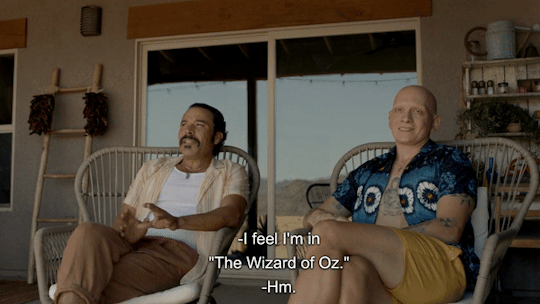

tin man.
#bill hader#hbo barry#barry season 4#anthony carrigan#noho hank#michael irby#barry spoilers#the wizard of oz#cristobal sifuentes#I actually despise bill hader because all the tin man wanted was to be a human being#to have a heart#and dorothy wants the safety of a home
138 notes
·
View notes
Text
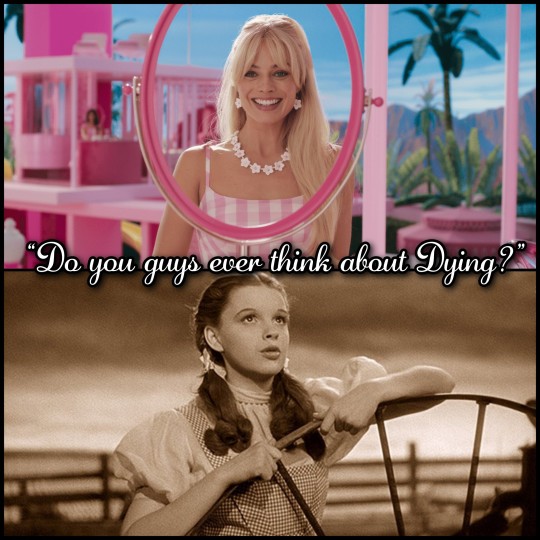

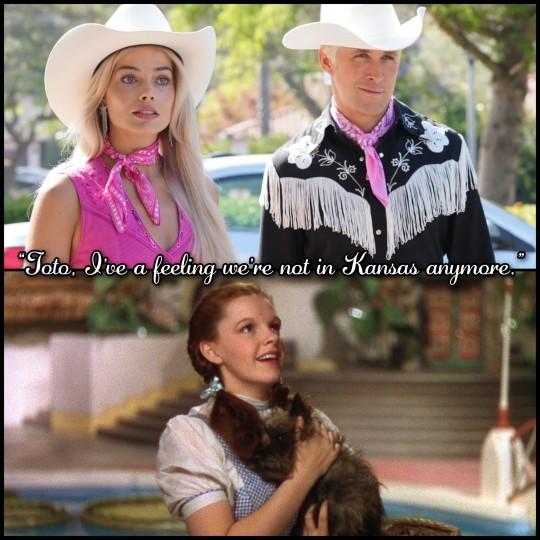





Wizard of Oz/Barbie Characters + Quotes 🌈👠🦁🪄
#Barbie#Greta Gerwig#Margot Robbie#Ryan Gosling#Ken#Weird Barbie#kate mckinnon#Allan#Michael Cera#Will Ferrell#the wizard of oz#dorothy gale#glinda#cowardly lion#tin man#somewhere over the rainbow#wicked#quotes#judy garland#i am kenough#im just ken#dance the night
32 notes
·
View notes
Text
Video Killed the Radio Star
If you don't already feel sufficiently alienated from the culture of your generation, consider getting into old time radio. It's pretty easy to do: Radio was mainstream media from the 1930s well into the 1950s, and it hung on for quite a while after it started losing ground to television. There's a huge amount of programming in various genres, and a surprising amount of it survives; there was a cottage industry in OTR cassettes and CDs for many years, a lot of shows can be found in MP3 format without much effort, and some of it pops up regularly on streaming platforms.
The easiest way to get into it is if you're already got a fondness for some older Hollywood star: If they were a movie star between 1930 and 1960, there's a good chance they guest-starred in various radio shows, and they might even have had their own show for a while. For instance, do you like Humphrey Bogart and Lauren Bacall? Around 1950, they had their own syndicated radio adventure series, BOLD VENTURE, which was essentially an extended riff on their characters in the 1944 film version of TO HAVE AND HAVE NOT. Orson Welles, of course, was a big radio star, playing the lead on THE SHADOW in 1937–38 and then bringing his Mercury Theatre company to a number of different one-hour and half-hour radio series. Vincent Price starred for several seasons as Leslie Charteris's Simon Templar on THE SAINT. And almost everyone who was anyone showed up now and again on SUSPENSE or LUX RADIO THEATRE (which produced all-star one-hour adaptations of popular movies). If you're a Superman or Sherlock Holmes fan, the radio versions of those characters are a must — Holmes was a perennial presence on English-language radio for decades.
If you want something more modern, the British kept producing generally high-quality radio dramas in surprising volume until relatively recently, including a range of both adaptations and originals. Unlike American radio, the survival rate for older British programs from the '40s and '50s is poor, but the BBC has continued periodically airing its better material from the '70s through the '00s, a lot of which has been offered on cassette and CD. For instance, there were excellent BBC radio series dramatizing the Wodehouse Jeeves and Wooster stories (with Michael Hordern and Richard Briers); Dorothy L. Sayers' Lord Peter Wimsey series (with Ian Carmichael); and Agatha Christie's Hercule Poirot mysteries (with John Moffat), along with standalone plays on programs like SATURDAY-NIGHT THEATRE. The big limitation with British radio dramas is that the number of British radio actors who can do convincing American accents is not high (and is definitely lower than the number who mistakenly think they can), and the availability of American actors who know how to act for radio is clearly even more limited, which can become a grating problem when dramatizing American material.
One of the reasons that listening to older (and/or British) radio shows will contribute to your cultural alienation is that it will make a lot of modern dramatic podcast series and audio dramatizations excruciating, because it will reveal to you how bad a lot of modern audio dramatists and performers are at this once commonplace art. (If you are or are contemplating doing a dramatic podcast or audio drama, please, for the love of dog, make a close study of radio shows created before you were born, and diversify enough to recognize the mediocrity of hacks like Dirk Maggs, who's been stinking up audio drama on two continents for four decades now.)
#old time radio#i actually hate the term old time radio#but it's a useful descriptor and it's not up to me#humphrey bogart#lauren bacall#orson welles#bold venture#vincent price#leslie charteris#sherlock holmes#superman#what ho jeeves#michael hordern#richard briers#dorothy l sayers#lord peter wimsey#ian carmichael#hercule poirot#john moffat#saturday night theatre#dirk maggs#radio#bbc radio
22 notes
·
View notes
Note
Hi!! Wanted to ask for some unicorns?

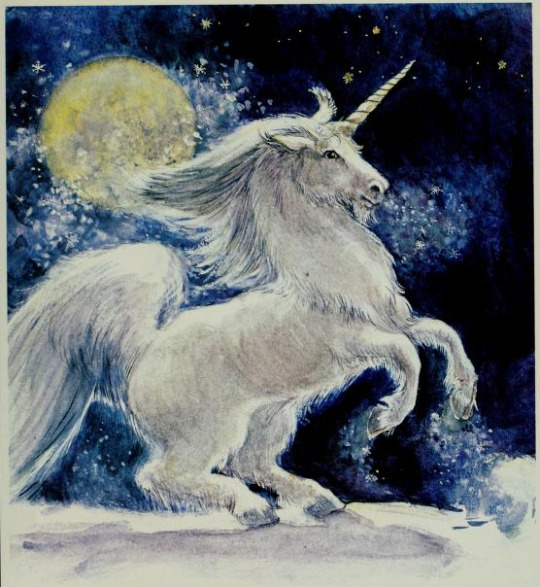

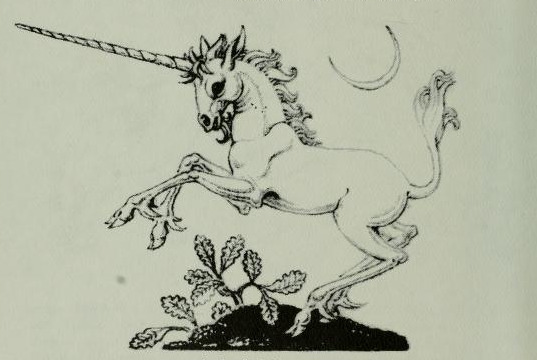
1.) Fabulous Beasts. Written by Alison Lurie, illustrated by Monika Beisner. 1981.
2.) A Book of Unicorns. Illustration by Melchior Lechter. 1978.
3.) A Book of Unicorns. Illustration by Michael Hague. 1978.
4.) A Book of Unicorns. Illustration by Dorothy Lathrop. 1978.
#mythical#unicorns#Monika Beisner#Melchior Lechter#Michael Hague#Dorothy Lathrop#requests#thrayonlosas
443 notes
·
View notes
Note
Trick or treat! I can't decide which emoji because they're all so good! I'm a sim this year, I made the plumbob out of green cardstock paper!

Our Boys dressed up too!
#trick or treat asks#love you sib!#halloween 1978#f13#michael myers#jason voorhees#myerhees#they're Dorothy and The Scarecrow from the wizard of Oz
34 notes
·
View notes
Text
The Gilded Age of Broadway Divas: Duets, Trios, and Other Crossovers
While I wait for my matinee show to start, here's our final compilation just six hours before our season finale. If you've been following along with this series, you'll notice how much overlap there is in the theatre. Everyone has been with, or sung with, or played the same role as everyone else. Here is just a taste of the sublime combined talents of our favorite Broadway Divas. And yes, this is my petition to have a musical episode.

#1: "Lily's Eyes," (The Secret Garden) Miscast 2022 - Audra McDonald and Kelli O'Hara
youtube
I watched this, and my soul transcended space and time. Performed at MCC's 2022 Miscast gala honoring Christine Baranski (of course), Audra and Kelli have a brief tiff about which soprano is worthy of Soprano Island before joining together to sing the most resplendent duet you will ever experience in your life.
The Secret Garden opened on Broadway in 1991 starring Rebecca Luker as Lily. Kelli and Audra are singing the parts of Lily's husband and brother-in-law respectively. And like Lily, Rebecca Luker has since passed away. Knowing that they are singing not only to honor Christine, but also to Rebecca, their dear friend and fellow soprano, is yet another layer of heartbreak. I love this song.
#2: "Move On," (Sunday in the Park with George) Princetown concert 2022 - Audra McDonald & Michael Cerveris
youtube
Former co-stars reunited in Princetown last year to sing this impromptu duet from the Pulitzer-winning Sunday in the Park with George. Sunday is filled with sublime music, and "Move On" is one of the best. In it, Dot appears to George, the grandson of Georges Seurat, and encourages him to move on with his artistry and stop worrying about perfection. The show itself is beautiful and complex, and a proshot is available for your convenience.
Audra and Michael had previously done a three-day, semi-staged production of this show in 2004, also featuring Patti LuPone as Yvonne/Blair Daniels (the role Christine Baranski created in the original pre-Broadway workshop). Interestingly, this trio would move on to take part in the Lincoln Center Broadcast of Passion in 2005 with Audra as Clara (the Marin Mazzie role), and Patti as Fosca (the Donna Murphy role).
Michael Cerveris would play Giorgio multiple times in his career, including the 10th Anniversary concert with Marin and Donna.
#3 Tonight: Quintet (West Side Story) - Lucky to Be Me: The Music of Leonard Bernstein (2010) - Kelli O'Hara, Donna Murphy, Michael Cerveris
youtube
Speaking of Michael Cerveris and Donna Murphy, and joined by Kelli O'Hara, this audio comes from a 2010 concert celebrating the music of Leonard Bernstein. The youtube video incorrectly attributes this to a 2012 concert, but it is not.
"Tonight (Quintet)" is, of course, from West Side Story, where Bernstein wrote the music, and Sondheim wrote the lyrics. Because this was a concert, certain singing parts are taken by those who would not sing such parts in a full production...anymore. (Lest we forget Natalie Wood in the movie.)
Donna sings Anita, and Kelli sings Maria, the two young Puerto Rican women in the show. And I think we'll leave that there. Michael Cerveris sings the part of Riff, and they are joined by Cheyenne Jackson as Tony.
Also featured in this concert is the amazing, incredible, beloved soprano Victoria Clark, who has starred opposite all three of our Gilded Age actors at one point or another. As the Margaret to Kelli's Clara (Light in the Piazza), the Sally to Donna's Phyllis (Encores! Follies), and in Titanic with Michael Cerveris. Theatre, it's all connected.
#4: LoveMusik (2007)
youtube
A little more on LoveMusik. While I've already detailed a little on my Donna Murphy post, here's some more about Michael Cerveris, two-time Tony winner. As Kurt Weill, Michael was nominated for a Tony, Drama Desk, Outer Critics Circle, and Drama League Award, but did not win any. While the show itself was given mixed reviews, the performances of Donna and Michael were almost universally praised.
The 2007 Tony Award for Best Leading Actress in a Musical included three Gilded Age nominees. Debra Monk (Curtains), Audra McDonald (110 in the Shade) and Donna Murphy (LoveMusik). All three lost to Christine Ebersole of the Grey Gardens variety. Fair. I suppose. However, Audra and Donna tied for the Drama Desk. And there WAS a wonderful clip of their award ceremony online for years, except now that I need it for this, it's been taken down. Of course.
#5: "At the Ballet," (A Chorus Line) - Audra McDonald & Kelli O'Hara
youtube
Joined by Megan Hilty, Kelli O'Hara and Audra McDonald performed "At the Ballet" from A Chorus Line at a Lincoln Center Marvin Hamlisch tribute in 2013. Audra showcases a robust lower range I simply adore. Unfortunately the lower key change leaves Kelli's soprano in an awkward place, but I love her anyway.
A Chorus Line is one of the musical theatre greats, and while "At the Ballet" is often overshadowed by "What I Did for Love," it's my personal favorite. The original stage show ran for 6,137 performances, and was nominated for twelve Tonys, winning nine. After Follies, this is the show I most want to see fully staged. A 50th Anniversary revival was rumored back in 2016 for 2025, but I'll believe it when I see it.
#6: The Ladies Who Lunch (Company) - Take Me to the World: A Sondheim 90th Celebration - Christine Baranski & Audra McDonald (ft. Meryl Streep)
youtube
Legends. Icons. Divas. What more can I say about "The Ladies Who Lunch," performed by Christine Baranski, Audra McDonald, and Meryl Streep, mother to Louisa Jacobson? As the story goes, they had done so many takes that by this time, they were well and truly on their way to being drunk. And yet, Audra McDonald still sounds more exquisite than anyone on earth.
I watched this when it premiered "live" on YouTube during the early days of the pandemic. Several Broadway stars who would go on to The Gilded Age are featured, including Kelli O'Hara, Laura Benanti, Nathan Lane, and Michael Cerveris.
It has been almost four years, and I have still not recovered from this song's placement in the concert. Picture it: you have just been emotionally wrung out by Donna Murphy's revelatory "Send in the Clowns," sung whilst seated in front of an Al Hirshfeld print of Passion, with her cleavage out in true Mrs. Astor fashion. And then suddenly there's jaunty Company music, and an illustration of the great Elaine Stritch with her martini glass high. And then there is Christine Baranski in a bathrobe and a truly massive glass of red wine. And you think it cannot get any better. And then the second verse hits and there's Meryl Streep with a cocktail mixer. AND THEN Audra Fucking McDonald. They put those two songs back-to-back and expected me to recover one day? As if.
Bonus: "Lips Together, Teeth Apart" (2018) - Nathan Lane & Christine Baranski
While not a musical performance, I would be remiss if I didn't direct your attention to this masterpiece. Did you ever think you'd hear Aunt Agnes gunning to see Ward McAllister's dick? No? Well, here it is. Terrence McNally wrote "Lips Together, Teeth Apart" specifically for his 1991 original cast which included Christine as Chloe and Nathan Lane as her brother Sam. And they are going through marital troubles with their respective spouses. Nathan and Christine reunited in 2018 to perform this scene for McNally's 80th Birthday.
But the Gilded Age connection doesn't stop there:
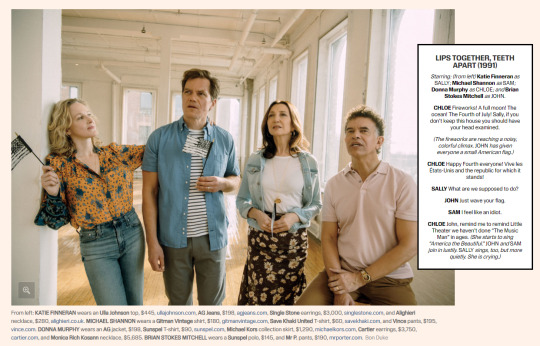
In 2019, The New York Times Magazine ran a special "America 2024" issue, as a tribute to Terrence McNally. The whole thing is a fantastic read, and I'd recommend it. In it features photoshoots depicting scenes from several of McNally's plays, including "Lips Together, Teeth Apart." And look who's here: Donna Murphy as Chloe (the Christine Baranski role), Broadway's Leading Man Brian Stokes Mitchell, Michael Shannon as Sam (the Nathan Lane role), and Katie Finneran.
And on one of four covers for this issue, Celia Keenan-Bolger.
With that, the conclusion to my little Diva miniseries. I hope you've found this as entertaining as I have. And if you'd like me to go into more detail about anything you've seen throughout this series, let me know, because I have so much more gossip and drama that I had to restrain myself from adding.
LINK TO MASTERPOST
#the gilded age#aurora fane#dorothy scott#lina astor#agnes van rhijn#ward mcallister#mr. watson (gilded age)#kelli o'hara#audra mcdonald#donna murphy#michael cerveris#christine baranski#nathan lane#sondheim#terrence mcnally#broadway#musical theatre
10 notes
·
View notes
Text

hi dorty
2 notes
·
View notes
Text
Slash: Orgy Of The Damned (2024)


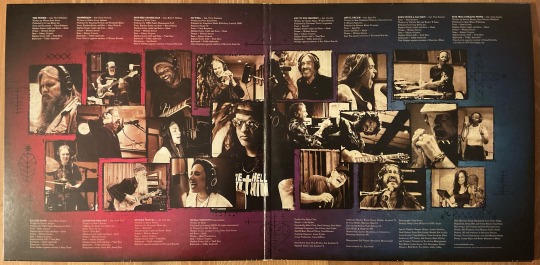

Cover Artwork By Toni Greis
Snakepit Records
#my vinyl playlist#slash#chris robinson#gary clark jr#billy gibbons#chris stapleton#dorothy#johnny griparic#teddy andreadis#iggy pop#steven tyler#paul rodgers#demi lovato#matt chamberlain#brian johnson#mike clink#tash neal#beth hart#michael jerome#les stroud#toni greis#guns n’ roses#snakepit records#blues rock#blues music#hard rock#record cover#album cover#album art#vinyl records
4 notes
·
View notes
Text
LET’S GET THIS SHOW ON THE ROAD
INTRODUCING THE FIRST GROUP:

IF YOU DON’T WANT TO ZOOM IN ON THIS SMALL FUCKING TEXT, HERE’S OUR FIRST MATCHES:
ICHIGO KUROSAKI vs. ADORABAT
EASY BAKE OVEN vs. CARMEN SANDIEGO
BERNIE SANDERS vs. OSCAR PINE
REIMU HAKUREI vs. MICHAEL JACKSON
BROLY vs. DOROTHY GALE
POPUKO vs. RiFF RAFF
TSUYU ASUI vs. NIMUE
SAYAKA KANAMORI vs. SANTANA
We’ll be running this group until the final two, at which point we’ll switch focus to group two! If your choice fighter hasn’t been in this round, don’t worry! They’ll be showing up plenty soon!
#Ichigo Kurosaki#Adorabat#Easy Bake Oven#Carmen Sandiego#Bernie Sanders#Oscar Pine#Reimu Hakurei#Michael Jackson#Broly#Dorothy Gale#Popuko#RiFF RAFF#Tsuyu Asui#Nimue#Sayaka Kanamori#Santana#tournament#bracket#polls
46 notes
·
View notes
Text
can't stop thinking now on how Michael couldn't shoot Hughes and couldn't/wouldn't shoot Tommy.
Whether Michael could have ever actually *directly killed* tommy really, except through second or third hand consequences to his decisions or actions. Because of that thing of how Michael cannot and will not link pleasure/fury/lust/satisfaction to killing. how Michael's 'revenge' on Tommy is actually driven by Tommy destroying (and/or failing to live up to) the way Michael perceives him.
Vengeance for Polly's death always felt like a painfully convenient excuse for Michael, a vessel for all that confusion and hurt to be placed in and carried on to the inevitable confusion. All while Tommy is vaguely aware but carries on in his way, regardless, because that's what Tommy does.
#Michael as a Frame and Mirror for one particularly distorted way of perceiving Tommy is what has interested me in Michael#but there is of course the fact Michael is an independent agent and has his own motivations too. which contribute to the distortion#will scott is absolutely this including his own distortion of his own act of thrusting the dagger to the hilt into lymond's hard body#jesus dorothy tone it down the slasher girls of the 1970s are getting delirious XD#this isn't the well thought out post just braindumping. need more thinking time on distortions and perceptions#and the way those idolised (against their will) can so fundamentally destroy the one who idolises them
5 notes
·
View notes
Text


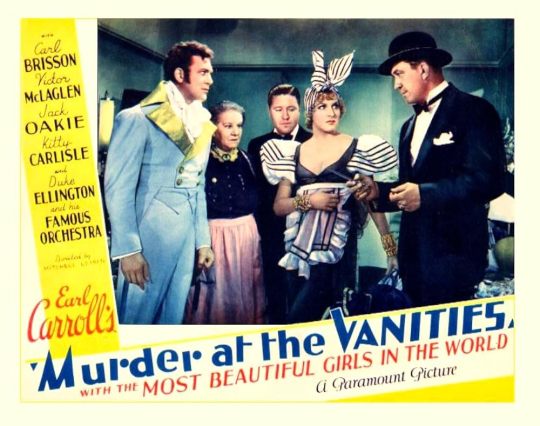
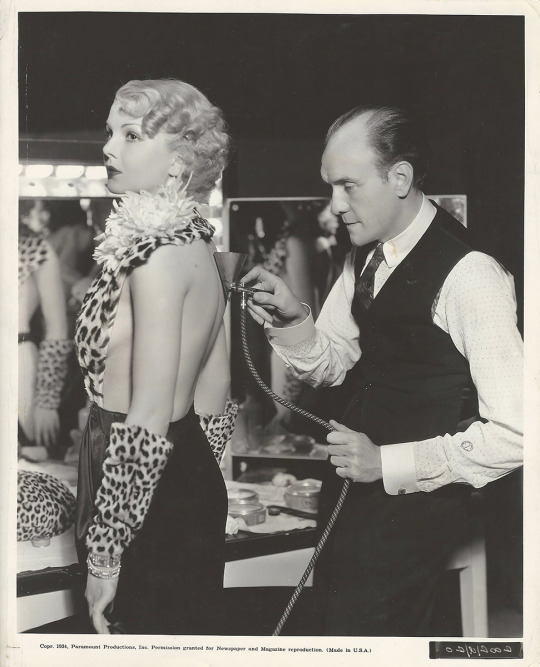


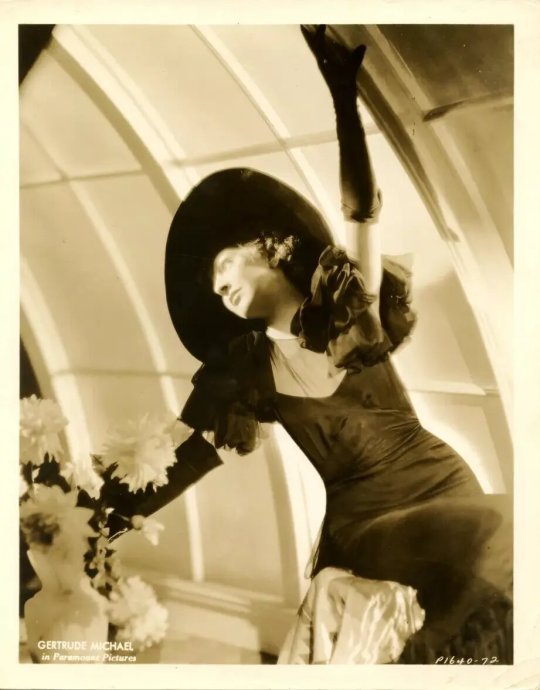
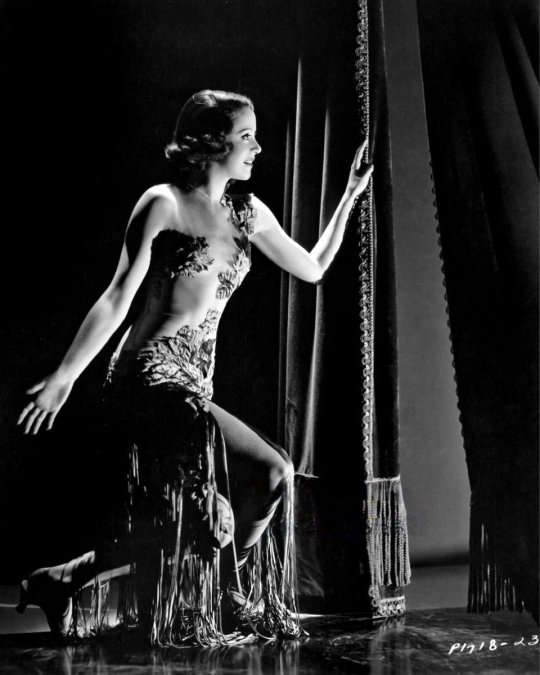


Murder at the Vanities (1934) Mitchell Leisen
April 2nd 2024
#murder at the vanities#1934#mitchell leisen#victor mclaglen#jack oakie#carl brisson#gertrude michael#dorothy stickney#kitty carlisle#jessie ralph#toby wing#charles middleton#gail patrick#donald meek#duke ellington#lucille ball#alan ladd#ann sheridan#pre-code#PreCodeApril
2 notes
·
View notes